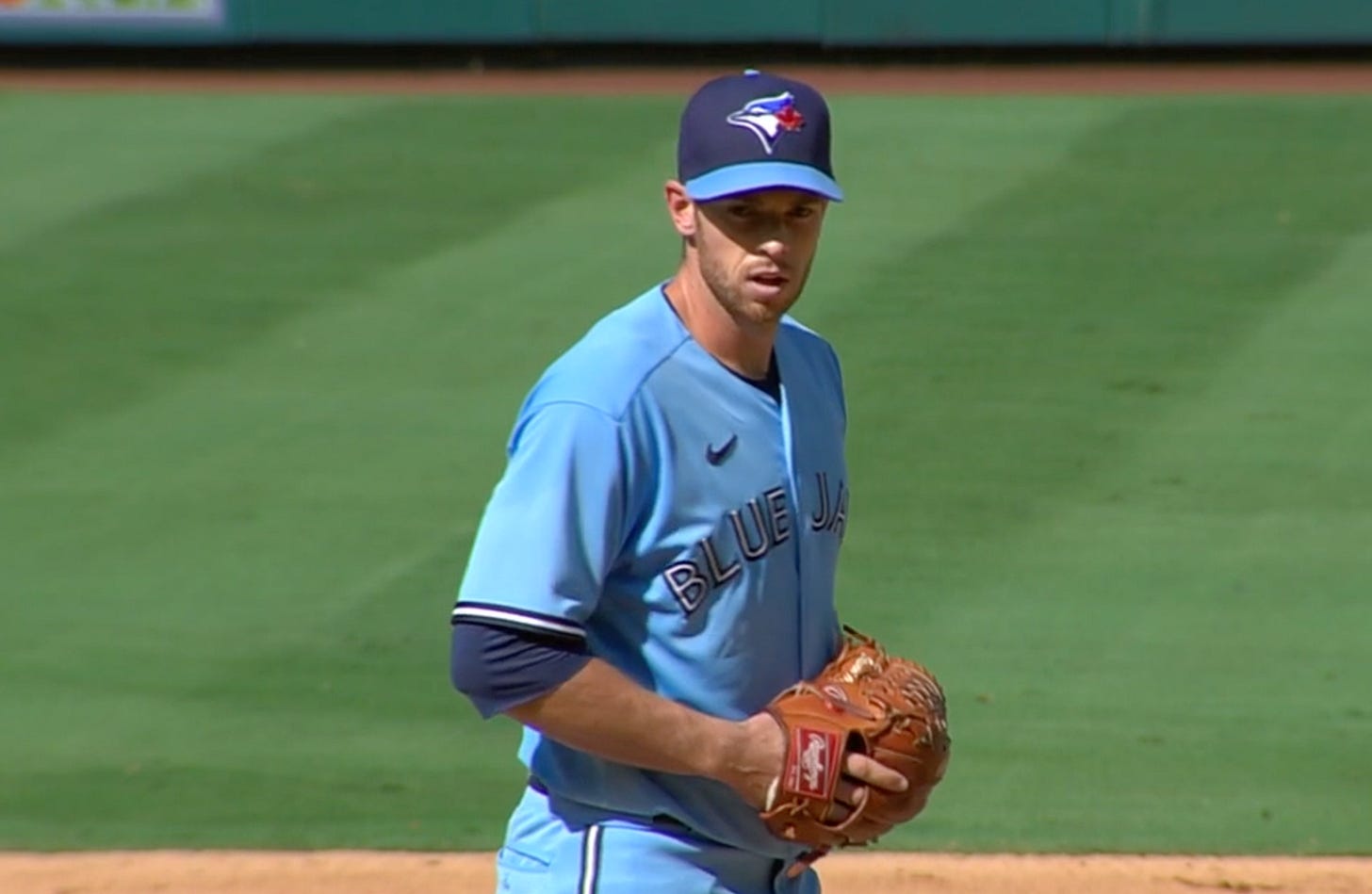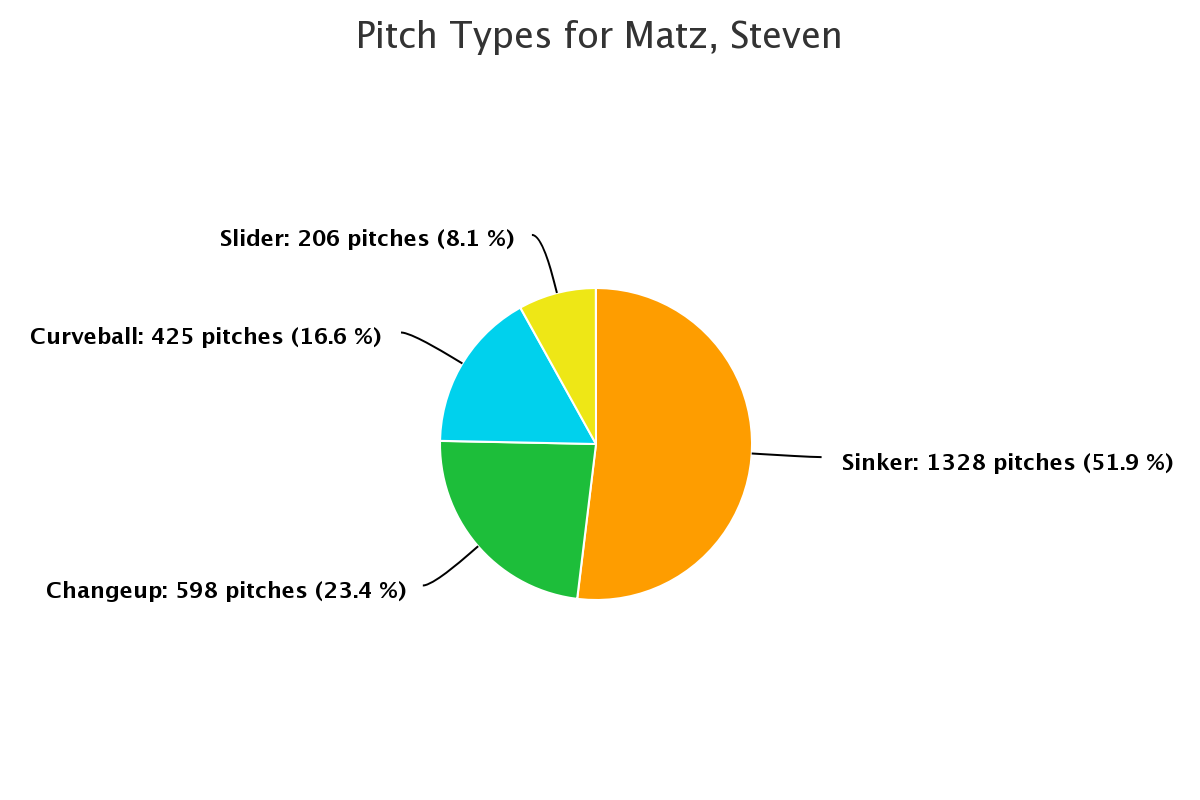Free agent target: Steven Matz
The first in a series of articles examining free agent pitching that could fit for the Royals, the spotlight shines on the southpaw late of Toronto. Could he feature in the Royals rotation?
The Hot Stove is beginning to spark and the Royals, along with 29 other teams, will be searching for pitching. It’s the currency of baseball, you know. Over the next few weeks, I’ll take a look at candidates who potentially fit the Royals’ budget and definitely fill a need.
First up: left-handed starter Steven Matz.
Subscribe now so you’re in the know about whom the Royals could target to add to their team for 2022. And hey, if one of these profiles proves prophetic, it will be well worth the money spent. (Crazy since this newsletter is free!)
Matz was drafted in the second round of the 2009 draft by the New York Mets. He made his debut in late June of 2015 and was a mainstay of the Met rotation for the next five seasons. After a miserable—and abbreviated—2020 campaign, New York shipped him to Toronto for Josh Winckowski, Yennsy Diaz and Sean Reid-Foley.
Granted a fresh start after that awful 2020, Matz made the most of the situation, posting perhaps the best season of his major league career. It certainly was at least according to fWAR. His 2.8 was the second time in seven seasons he topped the 2.0 fWAR mark and bettered his previous career-best, set in 2016.
From FanGraphs, here are the career numbers for Matz, along with the Steamer projection for the upcoming season.
His 2021 season was successful thanks to a strong second-half showing—He posted a 2.91 ERA (3.48 FIP) even though his strikeout rate was a pedestrian 7.5 SO/9 after the All-Star break. While Matz was allowing contact, it wasn’t particularly strong. His Hard Hit % of 38 percent was right in line with his career averages. He also kept the ball in the yard in 2021 with a 1.1 HR/9, his best rate since 2016. Hey, it always helps when you can avoid the long ball.
In seasons where Matz has thrown more than 130 innings, his peripherals have been remarkably consistent. His strikeout rate ranges from 8.9 to 8.6 SO/9. His walk rate is a little more fluid with a spread from 2.1 to 3.4 BB/9, but both rates represent outliers. His career walk rate of 2.7 BB/9 is more in line with his production the last couple of seasons.
Matz has a four-pitch mix, fronted by a sinker he offers over half the time.
In fact, Matz will throw the sinker at least half the time in any count to hitters from both sides of the plate. When I write he throws it half the time, that applies to any situation which is unique for a starter with a deep mix of pitches.
The sinker hovers in the mid-90s but features a below-average spin rate. Its active spin is 99 percent according to Baseball Savant, meaning almost all the spin he generates with the pitch contributes to its movement. Because his overall spin rate is so low on the pitch—it’s in the 36th percentile—despite the active spin, his sinker drops less than other pitchers. It’s falling about 2 inches less than the average Major League sinker.
The sinker turns into a ground ball 45 percent of the time it’s put in play against Matz. (Compared to a 24 percent fly ball rate.) As a lefty, he’s presumably facing a majority of right-handed hitters and those hitters are rolling it over to the left side of the infield.
It pays to have good defense up the middle (and third base) when Matz is on the bump. Given that, he would obviously fit in well with the Royals and their stellar defense which will presumably improve with the addition of Bobby Witt Jr. to the infield mix. Position the players (Witt Jr., Nicky Lopez, Adalberto Mondesi and Whit Merrifield) in whatever combination and wherever you like behind Matz. The southpaw should be a happy sinker ball pitcher with a trio of stellar defenders behind him.
Matz compliments the sinker with a changeup that has about 10 mph of separation and dives in the strike zone. It’s the offering that entices hitters to expand the zone the most, featuring a 37 percent chase rate. He throws the change more to right-handed batters and it shows up most frequently when he’s behind in the count.
Hitters managed just a .209 batting average against the Matz change in 2021 with a .341 slugging percentage. It’s not difficult to see why.
When batters are actually successful against the pitch and put it in play, Matz is generating a ground ball on the changeup 51 percent of the time. Again…that Royals infield defense could pay some dividends behind Matz.
The third pitch in his repertoire is a curveball that features more lateral break. It’s a pitch he will throw away to left-handed batters and in to righties. If Matz is looking to generate a swing and a miss, the curve is his best bet, getting a whiff over 31 percent of the time in 2021. Again, excepting his abbreviated 2020, the curve has been a consistent offering for Matz.
Averaging 155 IP in his most recent three full seasons, Matz hasn’t earned an innings eater sobriquet and with averagish spin rates and a 22 percent strikeout rate, he doesn’t possess the traits savvy organizations are now looking to mold and exploit. It puts Matz in the position of being a rather, ordinary, run of the mill, middle to back of the rotation starter. However, there’s some value there. And the Royals are looking for a veteran pitcher who can pick up 150 plus innings while shouldering some of the rotation heat as the young arms continue their development.
What you see is what you get with Matz at this point. He’s not going to take some giant leap forward with stuff, nor is he going to suddenly dominate hitters like an ace. So in Matz, you’re playing the old school free agent game of paying on what you saw in the past and hoping he can maintain his current levels for the duration of whatever contract he signs, even though he’s on the wrong side of 30. The defense is so important with Matz and his sinker-heavy repitoire. For a club to maximize his value as a starter, it’s imperative they have quality gloves behind him.
The leadership intangible the Royals will covet for this role is a question mark with Matz. Another issue to ponder is how left-handed do the Royals want to make their rotation. With Mike Minor and young starters Daniel Lynch and Kris Bubic presumably in the rotation for the moment, would a fourth lefty make sense? Or could Matz push Minor to the bullpen where he excelled in his first go-around with the Royals?
Let’s talk dollars. What would it take to get Matz to sign in a market that’s suddenly looking robust for starting pitchers? While he doesn’t possess the attractive peripherals like Eduardo Rodriguez, Matz is firmly in that middle tier of free agent starting pitchers. Industry consensus seems to be that he will receive a three-year contract around $33 million. Without a standout peripheral that teams seem to crave these days, an $11 million AAV seems a bit elevated.
Revisit that Steamer projection from earlier in this article. It’s estimating a slight uptick in home runs which pushes his ERA back above 4, but with stable strikeout and walk rates, you’re still looking at a pitcher who would finish with a fWAR above 2.0. And if you’re valuing a win at around $8 million (or more), a deal that pays Matz $11 million in his first season (if he hits his projection) would be a steal. Then once you calculate his aging curve along with inflation of the price per win, a contract with an $11 million AAV doesn’t seem so out of line.
My inclination when I began this exercise was to guesstimate a deal of around three years with a $9 million AAV. That certainly moves him into the Royals market. Now, I’m not sure that dollar amount gets it done. In fact, I think it will take a three-years at $36 million to bring Matz under contract.
Matz has been linked to the St. Louis Cardinals, the cross-state team that similarly features fantastic infield defense. The Red Sox have also been mentioned as suitors and chatter around them only figures to grow as they look for a replacement for the recently departed Eduardo Rodriguez. Also rumored to have interest are the Dodgers (naturally) and the Angels, who just signed Matz’s former teammate Noah Syndergaard to a puzzling one-year deal. It’s also possible he returns to Toronto. The Jays reportedly were mulling over giving Matz a qualifying offer.
Does he make sense for the Royals? If so, what type of contract would you give him? Thanks for reading and fire away in the comments.











